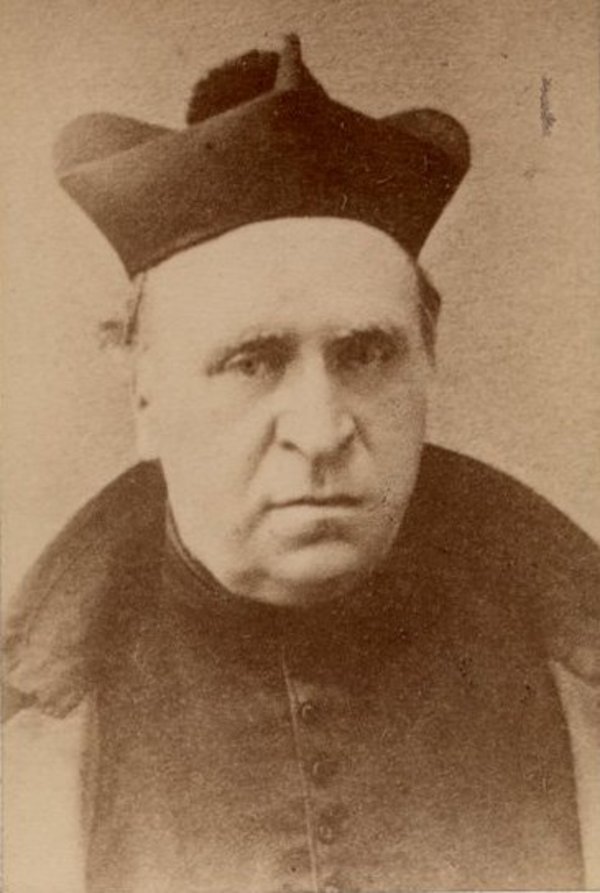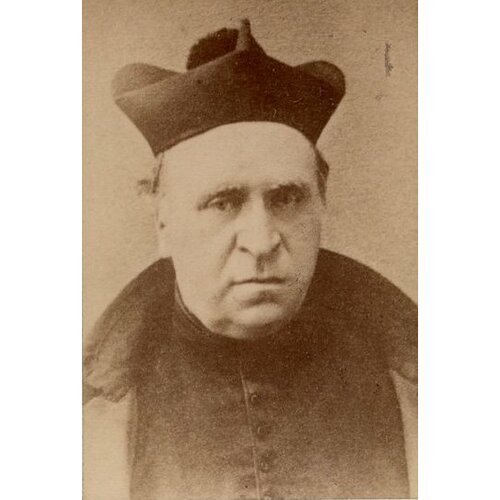
Source: Courtesy of Wikimedia Commons
BRAUN, ANTOINE-NICOLAS, Jesuit priest and writer; b. 5 Feb. 1815 at Saint-Avold, dept of Moselle, France, son of Antoine-Nicolas Braun and Marguerite-Victoire Simonet; d. 1 Feb. 1885 at Saultau-Récollet (Montréal-Nord), Que.
After completing his secondary education in his native parish Antoine-Nicolas Braun began theological studies at the Grand Séminaire de Metz, entered the noviciate of the Society of Jesus at Tronchiennes, Belgium, and in 1846 was ordained priest at Laval, France. He became curate at Laprairie (La Prairie) upon his arrival in Canada East in 1851, and four years later was appointed to serve at Quebec City, where he worked for 15 years. He was spiritual director of the Sisters of Charity of Quebec (1856–70), and at the request of Charles-François Baillargeon*, bishop of Quebec, drafted the community’s rules [see Marie-Anne-Marcelle Mallet*]. He was also director of the Congrégation des Hommes de la Haute Ville and a retreat preacher. On more than one occasion the bishop of Quebec delegated Lenten preaching at the cathedral to him. After hearing Father Braun’s lectures on Christian marriage in 1866 Bishop Baillargeon suggested that he publish the series. A letter from the general of the society, Father Pierre Beckx, finally persuaded Braun, and the Instructions dogmatiques sur le mariage chrétien was published at Quebec in 1866 and at Montreal in 1873. The book, which refuted the Gallican arguments of the French legal authority, Robert-Joseph Pothier, then being taught at Université Laval, led to pressures for Braun’s removal from the diocese of Quebec from which he was ousted in 1870.
Accepted by the Collège Sainte-Marie at Montreal, he was made a lecturer, and then devoted himself to preaching at the church of Le Gesù and in various parishes of the diocese. On the occasion of Bishop Ignace Bourget’s 50th anniversary in the priesthood, Braun preached a sermon on 29 Oct. 1872 and it provoked a protest which the newspapers helped stir up across the province. The reactions of the congregation and the public can largely be accounted for by unforeseen circumstances. It had been planned that Father Braun would preach to Bishop Bourget’s staff at the bishop’s palace, and that Bishop Louis-François Laflèche* would preach to the clergy and the public at the church of Notre-Dame. But when, at the last moment, Laflèche was unavailable Father Braun was assigned to Notre-Dame and was replaced for the sermon at the palace by Abbé Alexis Pelletier*, who after difficulties with the Quebec diocesan authorities had been accepted into the diocese of Montreal. A rigorist and strict Ultramontane, Father Braun extolled his bishop’s zeal for “sound principles”: the freedom of the church, the right enjoyed by a bishop to act independently of civil authority in erecting parishes, the struggle against Gallicanism and liberalism which endangered the faith. Since many priests and laymen did not give these “sound principles” as broad an interpretation as did Bishop Bourget, Braun aroused considerable animosity. On 10 Nov. 1872 Father Jean Bapst, the Jesuit superior of the province of New York, wrote Father Braun that his sermon appeared to him to be beyond reproach. The Holy Office expressed the same opinion in 1873, on the occasion of a trip Braun made to Rome with Bishop Laflèche. Seen in perspective, the sermon deserved, in the words of Racine’s Britannicus, “neither this undue honour, nor that affront.” It was but one incident in Father Braun’s life.
In 1869 the superiors of the society had asked Father Braun to study the Jesuits’ estates question, and to advise the legislators thereon. The issue had remained unsettled since the death in 1800 of Father Jean-Joseph Casot*, the last Jesuit in New France. England had then taken over the Jesuits’ estates, which it later gave to the united Province of Canada. Since all the land was in Quebec, the province had assumed responsibility for the estates at confederation, although the Jesuit order had returned to Canada in 1842. Braun published his Mémoire sur les biens des jésuites en Canada, par un jésuite in 1874, a learned treatise on ecclesiastical law, in which he made a case for the inalienability of the properties the church possessed or of those that had belonged to it but whose donors or owners were dead. He held that the church had the right and even the duty to repossess the latter properties if this were possible, and it was for the church, in the person of the Pope, to redistribute them in the closest possible conformity to the wishes of the deceased. Father Braun set forth the principles that led to the settlement of the Jesuits’ estates question. In 1888 the Quebec government of Honoré Mercier* and the Jesuit order in Canada, which was delegated ad hoc by the Holy See, reached an agreement. Then Pope Leo XIII portioned out the compensation deemed equitable by both parties: by a papal brief of 15 Jan. 1889 the Society of Jesus was granted $160,000 and land at Laprairie, the Université Laval received $100,000 and its affiliate in Montreal $40,000, and a further $100,000 was to be divided among the bishops in the province.
In 1875 Father Braun’s long-cherished project of establishing a Carmelite convent at Montreal was carried out. That year, to help recruiting and to introduce the public to the Discalced Carmelite Nuns, he published Une fleur du Carmel; la première carmélite canadienne, Marie-Lucie-Hermine Frémont, en religion sœur Thérèse de Jésus. The book is the story of a girl from Lévis, Que., who, believing she was called to the Carmelite life, went to Rheims, France, in 1872 to undertake her noviciate. She died there about six months later and the Carmelites of Rheims then decided to go to Montreal, arriving in May 1875. With Father Braun’s support Mother Séraphine du Divin Coeur de Jésus, the superior at Montreal, expected the convent to be surrounded by a stone wall in accordance with the rules of her order; the lay administrators thought the plan wasteful and held Father Braun responsible for it. To restore calm in a situation which had roused strong feelings, Bishop Bourget requested Father Braun to stay away from the convent. None the less Father Braun, a bold fighter, had judged there was room in Canada for this contemplative order, and time has proved him right. Two other Carmelite convents have been founded, one at St Boniface (Man.) in 1912, which was transferred to Trois-Rivières in 1929, and another at Quebec City in 1950.
From 1875 to 1885 Father Braun was attached to the church of Le Gesù as a preacher and confessor; in addition, he conducted retreats both in the town and in the country. Bishop Édouard-Charles Fabre*, who had a high opinion of Braun, often invited him to preach at the cathedral in Montreal. He was already exhausted when he was appointed to the noviciate at Sault-au-Récollet, then the home for aged and sick Jesuits; he died there on 1 Feb. 1885. Antoine-Nicolas Braun had been as inflexible in his personal life as in the guidance and preaching he had offered to others.
The principal writings of Antoine-Nicolas Braun are the following: Instructions dogmatiques sur le mariage chrétien (Québec, 1866; reimpr. Montréal, 1873); Mémoire sur les biens des jésuites en Canada, par un jésuite (Montréal, 1874); Une fleur du Carmel; la première carmélite canadienne, Marie-Lucie-Hermine Frémont, en religion sœur Thérèse de Jésus (Montréal, 1875; 3e éd., Québec, 1881).
Arch. de la Compagnie de Jésus, prov. du Canada français (Saint-Jérôme, Qué.), Fonds général, 1092, 5274; sér. A-1, 7; sér. BO37. L’Étendard (Montréal), 2 févr. 1885. Le Nouveau Monde (Montréal), 30 oct. 1872. Le Carmel au Canada français: mère Séraphine du Divin Cœur de Jésus, 1816–1888, fondatrice et prieure du Carmel de Montréal (nouv. éd., Montréal, 1944). R. C. Dalton, The Jesuits’ estates question, 1760–1888: a study of the background for the agitation of 1889 (Toronto, 1968). Paul Desjardins, Le Collège Sainte-Marie de Montréal (2v., Montréal, 1940–[44]), II: 186. Lareau, Hist. de la littérature canadienne. “Chronique diocésaine et provinciale,” La Semaine religieuse de Montréal, 6 (1885): 105–6.
Cite This Article
Léon Pouliot, “BRAUN, ANTOINE-NICOLAS,” in Dictionary of Canadian Biography, vol. 11, University of Toronto/Université Laval, 2003–, accessed January 1, 2026, https://www.biographi.ca/en/bio/braun_antoine_nicolas_11E.html.
The citation above shows the format for footnotes and endnotes according to the Chicago manual of style (16th edition). Information to be used in other citation formats:
| Permalink: | https://www.biographi.ca/en/bio/braun_antoine_nicolas_11E.html |
| Author of Article: | Léon Pouliot |
| Title of Article: | BRAUN, ANTOINE-NICOLAS |
| Publication Name: | Dictionary of Canadian Biography, vol. 11 |
| Publisher: | University of Toronto/Université Laval |
| Year of publication: | 1982 |
| Year of revision: | 1982 |
| Access Date: | January 1, 2026 |



